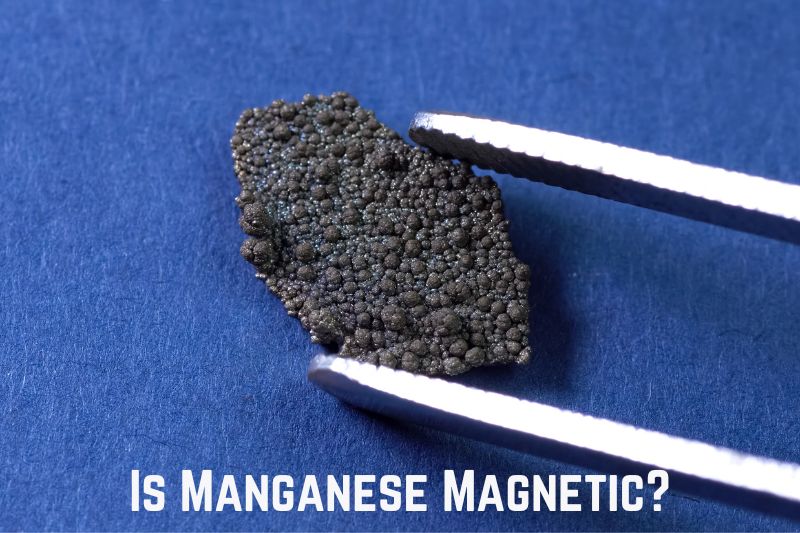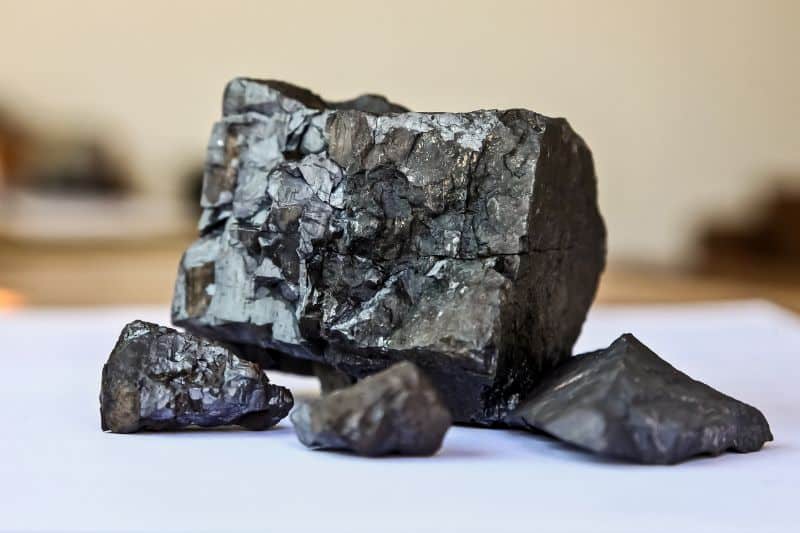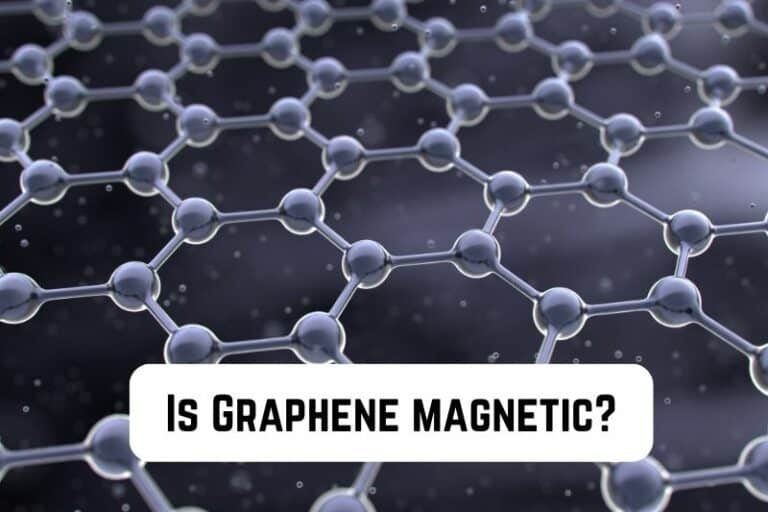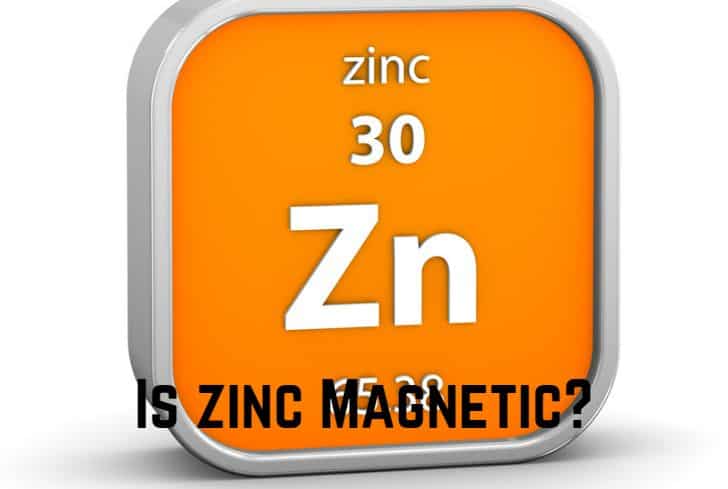Is Manganese Magnetic? (Find Out)

Most people tend to confuse manganese with iron. It might be primarily because both are silver-gray. Additionally, they share similar chemical and physical properties. But manganese does have a few properties that set it apart from iron. Is manganese magnetic?
Before outlining the differences between paramagnetism and ferromagnetism, we begin this article by stating whether manganese is attracted to a magnet and if it is paramagnetic or diamagnetic. In subsequent sections of the article, we will discuss factors influencing manganese magnetism, where manganese is found, and if manganese steel is magnetic. Finally, we discuss manganese’s properties and uses.
Read: Is Lithium Magnetic or Non-magnetic?
Is Manganese Attracted to Magnet?
Manganese does indeed have a small magnetic attraction. In its outer orbital shell, it has five unpaired electrons. The magnetic moment of a single unpaired manganese atom is intense. The manganese electrons cannot cancel the magnetism even when pointing in opposite directions. Manganese atoms are too close together, intensifying the magnetic moment.
A weak magnetic field typically forms as electrons spin and circle an atom’s nucleus. The unpaired electrons in the material spin and align parallel when exposed to a powerful magnet. The substance has now become magnetic.
Manganese is a chemical element with the atomic number 25 and the Mn symbol.
Is Manganese Paramagnetic or Diamagnetic?
Manganese is paramagnetic. Manganese and other paramagnetic minerals are weakly drawn to a magnet. Paramagnetic salts dominate the periodic table’s 4th to 7th row of transition metals. Diamagnetic materials, on the other hand, reject a magnet or oppose an applied magnetic field. Manganese possesses five unpaired electrons, whereas none exist in diamagnetic materials.
Manganese does have a magnetic attraction, but it wears off with time. When the magnet is taken away, paramagnetic materials lose their magnetic properties. By examining its electron configuration, you can determine a material’s paramagnetic or diamagnetic state.
Manganese has the electrical arrangement [Ar] 3d5 4s2. The manganese ion possesses the most unpaired electrons of any transition metal ion, 5, in a 3d subshell.
The subshells of the atoms in a paramagnetic substance are only partially filled with electrons. A diamagnetic atom has spin-paired electrons in every electron subshell.
Ferromagnetism vs. Paramagnetism
The Latin word for iron, which possesses powerful magnetic characteristics, is ferro. Ferromagnetic materials still retain their magnetic characteristics despite electron orbits. Afterwards, it shows extraordinary long-range ordering at the atomic level. In a region known as the domain, the unpaired electrons spin to align themselves parallel. The electron orbits do not cancel out in paramagnetic materials.
However, the electron fields do not interact with one another as strongly as they do in ferromagnetic materials. They, therefore, possess constant dipole moments that attempt to line up with the magnetic field.
However, random thermal motion prevents them from staying aligned. It also demonstrates that paramagnetic materials only exhibit magnetic properties in a powerful magnetic field. However, the net magnetic alignment is lost when the strong magnetic field is removed, and the dipoles resume their regular random motion.

Other properties also distinguish ferromagnetic from paramagnetic materials. I will provide you with a summary in the table below.
| Ferromagnetism | Paramagnetism |
| -Most materials are solid. | -The material can be either solid, liquid, or gaseous. |
| -Heavily attracted to a magnet. | -Slightly attracted to a magnet. |
| -Electrons move from high to low regions. | -Electrons move from low to high field region. |
| -After removing the external field, the material maintains the magnetic field. | -Once the external field is gone, they lose their magnetic property. |
| -Above the Curie temperature, they exhibit paramagnetic behavior. | -The material turns diamagnetic as the temperature rises. |
| -Materials produce a magnetic field. | -Materials align to an applied magnetic field. |
Caltech’s Feynman YouTube channel shows us the differences:
Is Manganese Steel Magnetic?
Manganese steel is non-magnetic. It has a lot of carbon but little magnetic material. Between 10 and 14% of manganese is present in manganese steel. The steel becomes harder and more brittle due to the high carbon content. Because manganese is a weak magnet and carbon is also non-magnetic, the final product is non-magnetic manganese steel.
Hadfield steel/grade is another name for manganese steel, which Sir Robert Hadfield first discovered in 1882. Compared to carbon steel, manganese steel has a higher impact strength and is less likely to rust. Additionally, it has self-hardening qualities. Manganese steel gets harder the more impact it endures.
Manganese has grown in popularity in the following industries:
- A good material for cement mixers, crawler treads, shovel buckets, and rock crushers and sizers.
- Due to its non-magnetic characteristics, it is suitable as a wear/impact plate for the bottom of electromagnets or separator drums.
- Manganese steel is ideal for shot-blasting cabinet liners in the casting and forging sector because they tend to get harder with continued use.
- Ideal for usage in commercial lifting magnets and electrical transformer assembly.
Where is Manganese Found?
Manganese is a naturally occurring element but is more abundant in pyrolusite and rhodochrosite minerals. Iron is another popular place to find it. Additionally, manganese nodules make up around 24% of the ocean floor. These nodules have a higher manganese content than terrestrial reserves. The mineral manganese is the twelfth most abundant in the crust of the Earth.
The main countries with manganese ores are Gabon, Brazil, China, and Australia. South Africa produces 80% of the world’s manganese.
The Latin word magnes, which means magnet, is where manganese comes from. Most people associate the name with pyrolusite, one of its main constituents, and its magnetic characteristics. In 1974, Johann Gottlieb became the first researcher to remove manganese from pyrolusite ore. He converted the manganese oxide to pure manganese using charcoal.
Factors Influencing Manganese’s Magnetism
We already know that manganese is paramagnetic. Three factors primarily influence manganese’s magnetism.
Electron Spin
The electrons in an atom typically occur in pairs. Every electron carries an electric charge. The electrical charge transforms into a magnetic field as an electron spins. Within the pair, each electron has a spin opposite to the other.
There is no net magnetic field because the magnetic fields of the paired electrons cancel one another out.
But in manganese, unpaired electrons result in a net magnetic field that responds to an outside magnetic field. As a result, each manganese atom behaves like a tiny magnet.
Electron Motion
Because electrons are constantly moving, a magnetic field occurs. The current loops created by the electron orbits contribute to a magnetic moment since they don’t cancel one another out. The strength of the paramagnetism is inversely correlated with the strength of the external magnetic field.
Atoms are more closely spaced in manganese. As a result, the electrons’ energy is high, which forces them to align in the same direction. The net magnetic moment remains when the unpaired electrons face the same direction. Manganese is, hence, only moderately attracted to a magnet.
Properties of Manganese
The primary use of manganese is as an iron and steel alloying agent. The Roman Empire used manganese for their weapons because it improved the ability to hot-work steel. However, manganese’s popularity is due to a variety of additional properties.
Physical Properties
- Iron-like metal that is hard, brittle, and silvery.
- Though difficult to melt, it oxidizes readily.
- Tarnishes slowly in the air.
- Manganese has a body-centered crystal structure.
- Breaks down gradually in water.
Chemical Properties
- Made up of a single stable isotope.
- When in its pure state, chemically reactive. It dissolves in weak acid, reacts with water, and burns in powder form.
- The boiling point is 3,744 °F (2,062 °C) and its melting point is 2275 °F (1246 °C).
- Displays several oxidation states.
- Consists of manganese-55, a single isotope.
- It has a 7.21 g/cm3 density at room temperature.
Read: Is Neon Magnetic or Non-magnetic? (Answered)
Uses of Manganese
Most people might not be aware of manganese’s importance to human health as a mineral. Some foods that contain manganese include whole grains, green vegetables, legumes, nuts, tea, and whole grains. But manganese also has a variety of other uses, which we highlight in the table below.
| Industry | Manganese application |
| Alloys | -Manganese enhances the steel’s resistance, stiffness, and strength. |
| -Principal element of cheaper stainless steel. | |
| -Aluminum alloy, which prevents corrosion in aluminum. | |
| -Made into ferromagnetic alloys. | |
| Glass /ceramics | -Used in pigments to decolorize green glass and provide a purple tint to clear glass. |
| -A ceramic coloring agent. | |
| Automotive | -Used to reduce engine knocking. |
| -Manganese is sometimes used in alkaline and dry cell batteries. | |
| Fuel | -Organo-manganese compounds are added to gasoline to increase its octane rating. |
| Plants, humans and animals | -Necessary for mitochondria in plants and animal cells to operate. |
| -It is necessary for the consumption of vitamins and aids in metabolism in both humans and animals. | |
| -Aids the body’s connective tissue in developing. | |
| Chemistry | -Manufacture of chlorine and oxygen. |
| -Used as a reagent in the oxidation of benzoylic alcohols. |
Conclusion
One of the distinguishing factors between manganese and iron is their magnetic properties. Iron is ferromagnetic, but manganese is paramagnetic. You’ve noticed their distinctive characteristics after reading the content above.
However, the steel and manganese alloy known as manganese steel is not magnetic. The alloy’s high carbon content cancels out manganese’s magnetic moment. Magnetic steel is more likely to contain iron.






